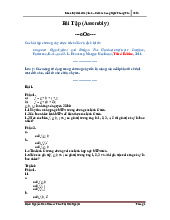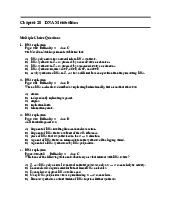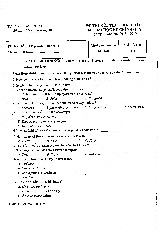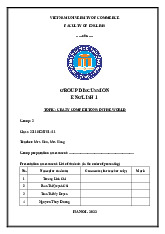



Preview text:
Kiểu dáng công nghiệp trong tiếng Anh là gì?
1. Thế nào là kiểu dáng công nghiệp?
Kiểu dáng công nghiệp là một khía cạnh quan trọng của sự đặc sắc trong
thiết kế sản phẩm, được xác định bởi hình dáng bên ngoài của đồ vật, dụng
cụ, thiết bị, phương tiện hoặc các bộ phận sử dụng để lắp ráp và hợp thành
sản phẩm. Quyền sở hữu kiểu dáng công nghiệp đặt ra những yêu cầu cụ thể
để có thể đăng ký và nhận được bảo hộ, bao gồm:
- Kiểu dáng công nghiệp phải mang tính mới, tức là nó không được công bố
trước đó trong bất kỳ tài liệu nào khác trước thời điểm đăng ký. Điều này đảm
bảo rằng kiểu dáng là độc đáo và đáng chú ý.
- Kiểu dáng cần phải mang lại ấn tượng của sự sáng tạo, không được sao
chép từ những mô hình đã tồn tại trước đó một cách đơn giản.
- Kiểu dáng cần phải có khả năng áp dụng trong môi trường công nghiệp,
đảm bảo tính thực tế và khả thi khi sản xuất hàng loạt.
- Quyền sở hữu kiểu dáng công nghiệp chỉ được bảo hộ khi được đăng ký tại
cơ quan có thẩm quyền. Việc này đòi hỏi sự đệ trình đầy đủ thông tin và hình
ảnh minh họa để chứng minh tính mới, sáng tạo và khả năng áp dụng công nghiệp của kiểu dáng.
Khác với quyền tác giả tự động, quyền sở hữu kiểu dáng công nghiệp đòi hỏi
một quá trình đăng ký chặt chẽ để đảm bảo quyền lợi và bảo vệ sự độc đáo
của sản phẩm trong lĩnh vực công nghiệp. Quyền sở hữu kiểu dáng công
nghiệp chỉ được bảo hộ khi đăng ký tại cơ quan có thẩm quyền, điều này đặt
ra những yêu cầu nghiêm túc về độc đáo và tính độc quyền của kiểu dáng.
Bảo vệ quyền sở hữu kiểu dáng công nghiệp đóng vai trò quan trọng trong
việc thúc đẩy sự đổi mới và cạnh tranh trong lĩnh vực sản xuất và kinh doanh.
2. Kiểu dáng công nghiệp bằng tiếng anh là gì?
Kiểu dáng công nghiệp tiếng Anh là: Industrial Designs
The term "Industrial Designs" in English, as per the provisions of Section 13,
Article 4 of the Intel ectual Property Law of 2005, amended and supplemented
in 2009, can be comprehensively understood as fol ows:
- Legal Definition: An industrial design, in legal terms, refers to the decorative
or ornamental aspect of a product. It is embodied by the three-dimensional
configurations, lines, colors, or a combination of these elements. This legal
definition emphasizes the visual features that contribute to the aesthetic appeal of a product.
- In a Legal Context: An industrial design may include three-dimensional
features such as the overal shape of an article or two-dimensional features
like pat erns, lines, or colors. This broader definition acknowledges that the
design can manifest in various dimensions and aspects, ensuring a
comprehensive coverage of the ornamental attributes.
- Professional Practice Definition: In a professional context, Industrial Design
(ID) is the practice of designing products, devices, objects, and services used
by mil ions worldwide every day. Industrial designers focus not only on the
physical appearance but also on the functionality and manufacturability of a
product. Their involvement often extends throughout the entire development
cycle, ensuring the overal lasting value and user experience of a product or service.
- Key Focus Areas: Industrial designers emphasize the visual appeal,
functionality, and feasibility during the design process. They play a crucial role
in shaping how a product looks, feels, and operates. Their work goes beyond
aesthetics, considering the practical aspects and user experience, ensuring
that the end product meets both functional and visual requirements.
In summary, "Industrial Designs" encompass the aesthetic features of a
product, as defined by its three-dimensional configurations, lines, colors, or a
combination of these elements. Both legal y and professional y, this term
emphasizes the importance of visual appeal and functionality in the design
process. "Industrial Designs" in English refer to the ornamental or aesthetic
aspect of a product, as defined by the legal provisions of Article 4, Clause 13
of the Intel ectual Property Law in 2005, amended and supplemented in 2009.
This term not only reflects the aesthetics of the product but also encompasses
geometric features and colors. In a professional context, it denotes the
practice of designing products and services used by mil ions of people daily.
Industrial designers focus not only on the physical appearance but also on
functionality and manufacturability, aiming to provide lasting value and a
positive experience for end-users throughout the development cycle.
3. Ví dụ về các kiểu dáng công nghiệp trong tiếng anh
- According to the Law on Intel ectual Property 2005, certain objects are
excluded from protection as industrial designs.
=> Theo quy định của Luật Sở hữu trí tuệ năm 2005, một số đối tượng sẽ
không được bảo hộ dưới dạng kiểu dáng công nghiệp.
- Two industrial designs shal not be considered significantly different from
each other if they are only different in appearance features that are not easily
noticeable, memorable, and cannot be used to distinguish these industrial designs as a whole.
=> Hai kiểu dáng công nghiệp không được coi là khác biệt đáng kể nếu
chúng chỉ khác biệt về những đặc điểm về hình thức không dễ dàng nhận biết,
ghi nhớ và không thể sử dụng để phân biệt tổng thể giữa chúng.
- VinFast has recently applied for industrial design protection for 11 new car models.
=> VinFast vừa đăng ký bảo hộ kiểu dáng công nghiệp cho 11 mẫu ô tô mới của họ.
- Industrial design is often the first tangible element of a product that appeals to consumers.
=> Kiểu dáng công nghiệp thường là yếu tố hữu hình đầu tiên của một sản
phẩm tạo ra sự hấp dẫn đối với người tiêu dùng.
- Industrial design is crucial as it serves not only functional purposes but also
aesthetic and marketing objectives.
=> Kiểu dáng công nghiệp rất quan trọng vì nó không chỉ đáp ứng mục đích
chức năng mà còn mục tiêu về mặt thẩm mỹ và tiếp thị.
- The protection of industrial designs plays a vital role in fostering innovation
and encouraging businesses to invest in the development of unique and visual y appealing products.
=> Việc bảo hộ kiểu dáng công nghiệp đóng một vai trò quan trọng trong việc
thúc đẩy sự đổi mới và khuyến khích doanh nghiệp đầu tư vào việc phát triển
sản phẩm độc đáo và hấp dẫn về mặt hình thức.
- The criteria for determining the distinctiveness of industrial designs include
their novelty, creativity, and applicability in industry.
=> Các tiêu chí để xác định sự độc đáo của kiểu dáng công nghiệp bao gồm
tính mới mẻ, tính sáng tạo và khả năng áp dụng trong ngành công nghiệp.
- The registration of industrial designs provides creators and businesses with
exclusive rights over their visual creations, safeguarding them from
unauthorized use or reproduction.
=> Việc đăng ký kiểu dáng công nghiệp cung cấp quyền độc quyền cho người
sáng tạo và doanh nghiệp đối với tác phẩm sáng tạo của họ, bảo vệ chúng
khỏi việc sử dụng hoặc sao chép không được phép.
- The industrial design landscape is dynamic, reflecting changes in consumer
preferences, technological advancements, and market trends.
=> Kiểu dáng công nghiệp là động đậy, phản ánh sự thay đổi trong sở thích
của người tiêu dùng, sự tiến bộ về công nghệ và xu hướng thị trường.
- Enforcement of industrial design rights is essential to prevent infringement
and ensure fair competition in the market. This involves taking legal actions
against those who unlawful y copy or use protected designs.
=> Việc thực thi quyền kiểu dáng công nghiệp là quan trọng để ngăn chặn
việc vi phạm và đảm bảo sự cạnh tranh công bằng trên thị trường. Điều này
bao gồm việc ra quyết định pháp lý đối với những người sao chép hoặc sử
dụng kiểu dáng được bảo hộ một cách bất hợp pháp.
- The duration of industrial design protection is limited, typical y ranging from 5
to 25 years, depending on the jurisdiction. After this period, the design enters
the public domain, al owing others to use or reproduce it freely.
=> Thời hạn bảo hộ kiểu dáng công nghiệp là có hạn, thường dao động từ 5
đến 25 năm, tùy thuộc vào quy định của quốc gia. Sau khoảng thời gian này,
kiểu dáng sẽ trở thành tài sản công cộng, cho phép người khác tự do sử dụng hoặc sao chép.
- International agreements, such as the Hague Agreement Concerning the
International Deposit of Industrial Designs, facilitate the process of obtaining
protection for industrial designs in multiple countries through a single application.
=> Các thỏa thuận quốc tế, như Hiệp định Hague về Gửi giữ quốc tế cho Kiểu
dáng Công nghiệp, hỗ trợ quá trình đạt được bảo hộ cho kiểu dáng công
nghiệp ở nhiều quốc gia thông qua một đơn đăng ký duy nhất.
- The advancement of digital technologies has introduced new chal enges in
protecting industrial designs, such as the ease of digital reproduction and the rise of online counterfeiting.
=> Sự tiến bộ của công nghệ số đã đưa ra những thách thức mới trong việc
bảo vệ kiểu dáng công nghiệp, như sự dễ dàng trong việc sao chép số và sự
gia tăng của việc làm giả mạo trực tuyến.
Document Outline
- Kiểu dáng công nghiệp trong tiếng Anh là gì?
- 1. Thế nào là kiểu dáng công nghiệp?
- 2. Kiểu dáng công nghiệp bằng tiếng anh là gì?
- 3. Ví dụ về các kiểu dáng công nghiệp trong tiếng




